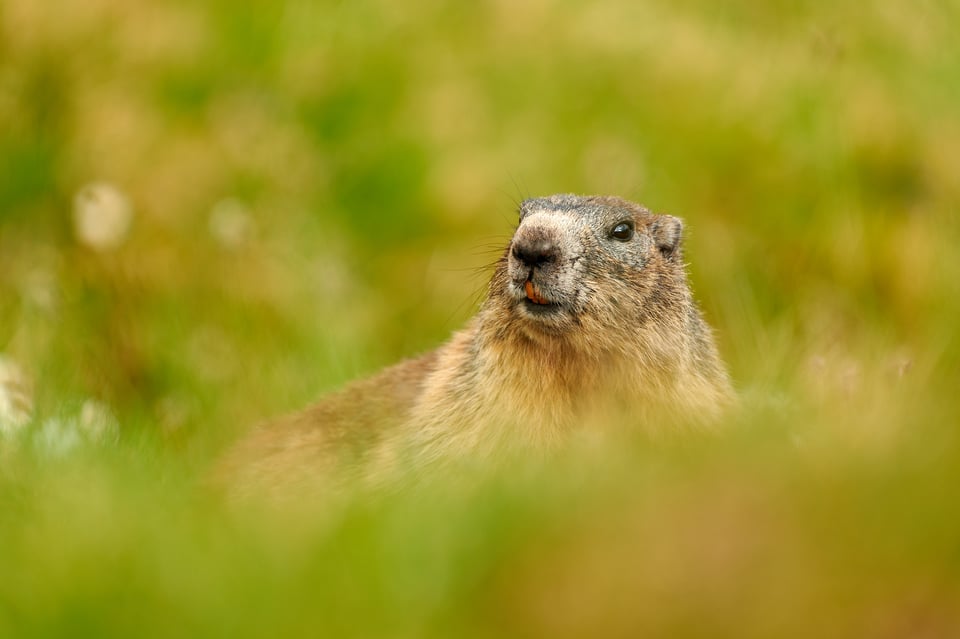Alpine Marmots may seem like the archetype of cuteness, with their furry coats, stocky bodies, and friendly faces. But as it happens, the reality is very different from the first impression. To photograph marmots, I traveled to the Austrian Alps and spent a week with them, 2500 meters above sea level in the shadow of the Grossglockner.

During the time I spent photographing them, I realized that the life of a marmot is tough, like the life of any mountain creature. After all, high mountains covered with snow for six months of the year are no seaside resort. However, it is not only the climatic conditions that are hard, but also the nature of the marmots themselves.

Marmots live in family groups of five to fifteen members. This family unit is far from an idyllic coexistence of several generations. It is led by a dominant pair, who are the only ones allowed to reproduce. They achieve this privilege through constant bullying of subordinate family members. The offspring of previous broods have such high levels of stress hormones that their reproduction is inhibited.

Their job is to care for the youngest siblings, and during hibernation, they serve as a source of warmth that keeps the entire family alive. So while the frost rages outside and icy gusts blow, marmots huddle together in their underground burrows to conserve precious heat and energy. Their heart rates drop to less than a quarter, and breathing slows to just a few breaths per minute. Those who have not managed to build up enough fat reserves during the summer will not survive until spring. This happens most often to the youngest generation.

What if a young individual full of energy wants to become independent and start his own family? Then he must leave the colony and seek his fortune elsewhere. But wherever it goes, it can expect nothing but stiff resistance. Usually, the way to a family of its own is through bloodshed. Sometimes it even removes its own parents from the way. Truly Shakespearean dramas sometimes take place on the slopes of the Alps.


Even when the dominant pair changes, peace and harmony do not return to the colony. The new male sometimes kills the offspring of his defeated rival. Infanticide is found in a number of mammals, such as lions, but for somewhat different reasons. By killing cubs, lions interrupt lactation and thus hasten the onset of oestrus in lionesses.
What about marmots? Killing the cubs would not result in another litter in the same year anyway. Mountain summers are too short for that. Instead, a female that has lost her cubs will be able to gather more energy before the upcoming winter, and the energy costs of the whole group during hibernation will be reduced. As a result, the female is more likely to make it to the next spring in good condition and provide the new male with more healthy cubs next year.


Observations of infanticide among marmots are relatively rare, so I consider it a sad privilege to have witnessed it with my own eyes. There are often smaller or larger skirmishes between marmots. Even the juveniles can be seen in pretend scuffles that soon become deadly serious.


Once, as I was walking by a colony of marmots, I noticed some unusual activity. A male that I had photographed at several other skirmishes had unexpectedly attacked one of the pups. The cute little fur ball that had just been frolicking with its siblings was now lying in front of its burrow with its neck bitten off. It all happened so fast that I don’t have a single photo of the whole event.

The life of a marmot was never easy. Recently, however, the marmots’ daily bread has become even harder than usual. Warming temperatures are bringing more heat in the summer, but paradoxically more cold in the marmot burrows in the winter. This is due to insufficient snow cover, which does not protect and insulate the hibernating marmots as it once did. Even huddling together like penguins in Antarctica is not always enough.
So, the survival rate of offspring from a large colony is beginning to differ less and less from the survival rate of a single, independent marmot pair. This may lead to a reduced willingness to accept the bullying from a dominant couple and lead more marmots to go off on their own. Thus, the traditional marmot family (with all its virtues and vices) begins to break down like the Alpine glaciers.


Like people facing a flood, the marmots move higher and higher up the mountainside in order to hide under deeper snow. But there is no Noah’s Ark waiting for them at the top. As their habitat shrinks, so does the marmot population. Their numbers are estimated to be declining by 4% per year. So, what was once an abundant animal may soon become one of the growing number of entries in the Red Data Book.


Europe’s mountains would be a much sadder place without these remarkable rodents. They are inseparable from the character of high alpine meadows, with the way they sit on their hind legs, skirmish around, and whistle to warn other members of the colony of predators. My hope is that by showing you the fascinating and fierce ways in which they live, you will gain a respect for these creatures and look for them next time you find yourself taking pictures in the mountains.










